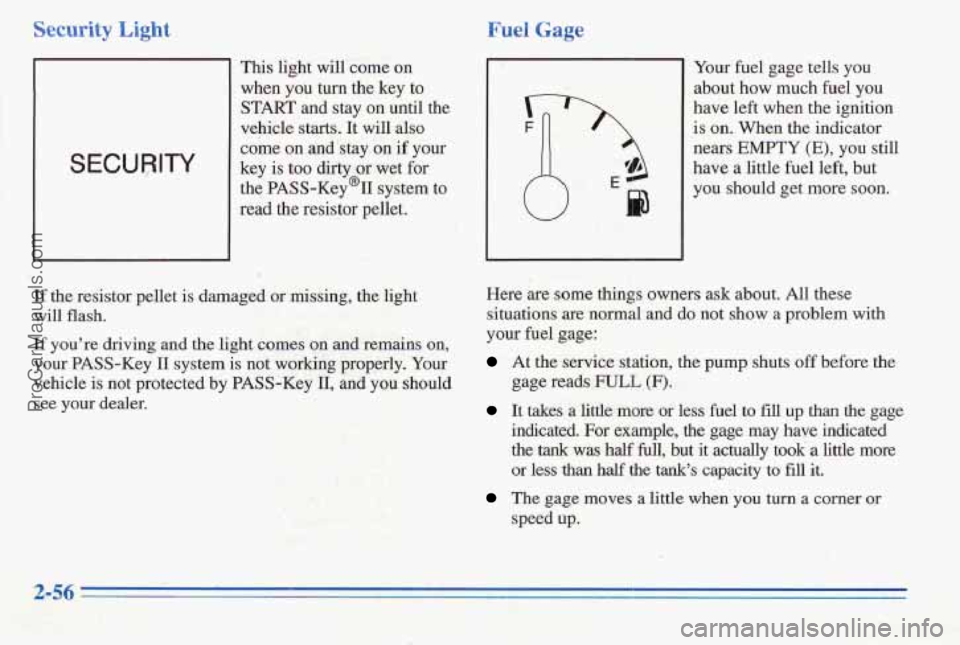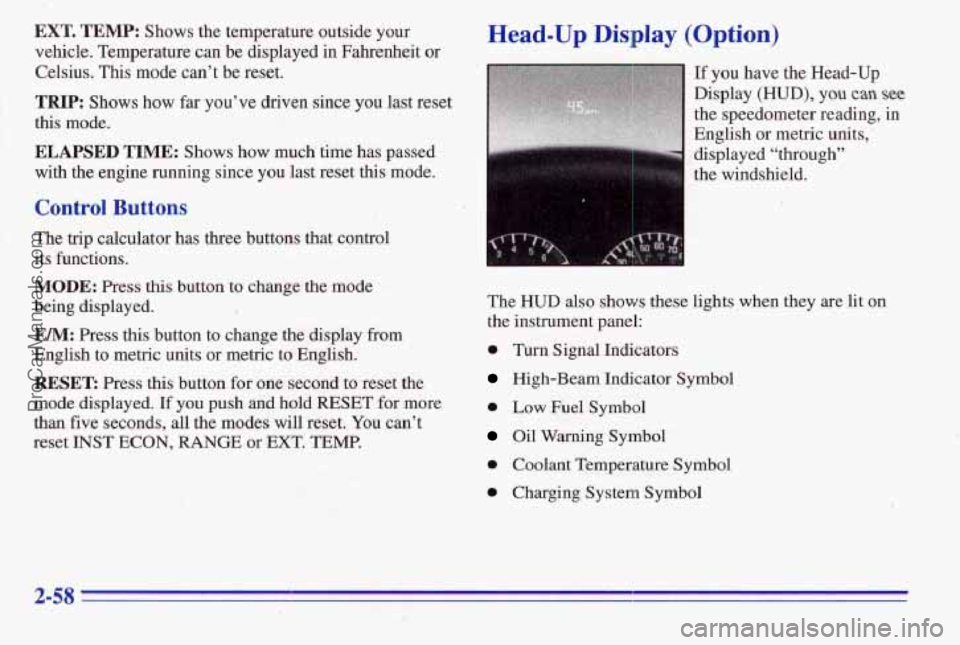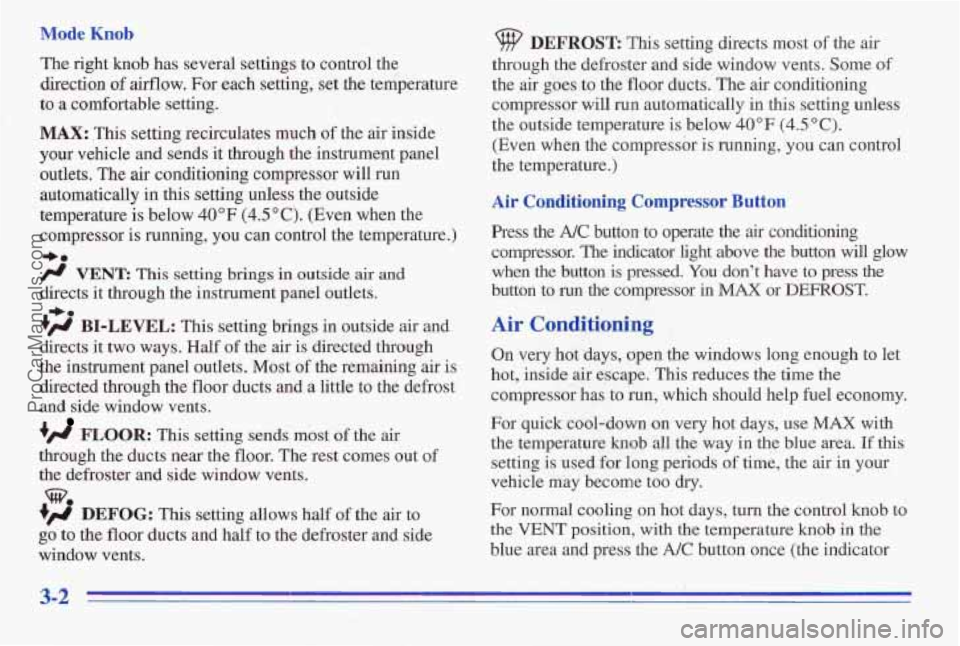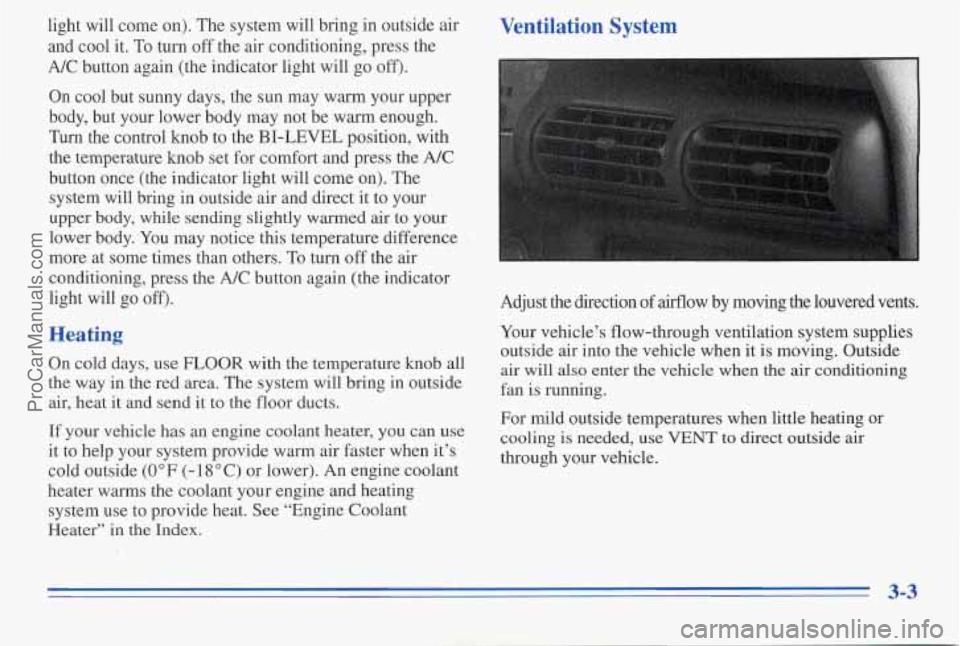1996 PONTIAC PONTIAC light
[x] Cancel search: lightPage 122 of 370

If the Light Is Flashing
The following may prevent more serious damage to
your vehicle:
If the Light Is On Steady
0 Reduce vehicle speed.
0 Avoid hard accelerations.
0 Avoid steep uphill grades.
0 If towing a trailer, reduce the amount of cargo ,being
hauled as soon as it is possible.
If the light stops flashing and remains
on steady, see “If
the Light Is On Steady” following.
If
the light continues to flash, when it is safe to do so,
stop the vehicle. Put your vehicle in PARK (P). Turn the
key off, wait at least 10 seconds and restart the engine.
If the light remains on steady, see “If the Light Is On
Steady” following.
If the light is still flashing, follow the
previous steps, and drive the vehicle to your dealer or
qualified service center for service.
You may be able to correct the emission system
malfunction by considering the following:
Did you just put fuel into your vehicle?
If
so, reinstall the fuel cap, making sure to fully install
the cap. The diagnostic system can determine if the fuel
cap has been left off or improperly installed.
This will
allow
fuel to evaporate into the atmosphere. A few
driving trips should turn the light off.
Did you just drive through a deep puddle of water?
If
so, your electrical system,.may be wet. The condition
will usually be corrected when the electrical system
dries out. A few driving trips should turn the light
off.
Are you low on fuel?
As your engine starts to
run out of fuel, your engine may
not run as efficiently as designed since
small amounts of
air are sucked into the fuel line causing a misfire. The
system can
detect this. Adding fuel should correct this
condition. Make sure to install the fuel cap properly. It
will take a few driving trips to turn the light off.
2-53
ProCarManuals.com
Page 123 of 370

Have you recently changed,brands of fuel?
If
so, be sure to fuel’ your vehicle with quality fuel (see
“Fuel” in the Index). Poor fuel quality will cause your
engine not to run as efficiently as designed.
You may
notice
this as stalling after start-up, stalling when you
put the vehicle into gear, misfiring, hesitation on
acceleration or stumbling on acceleration. (These
conditions may
go away once the engine is warmed up.)
This will be detected by the system and cause the light
to
turn on.
If you experience this condition, change the
fuel brand
you use. It will require at least one full tank of the
proper fuel to turn the light
off.
If none of the above steps have made the light turn off,
have your dealer or qualified service center check the
vehicle. Your dealer has the proper test equipment
and
diagnostic tools to fix any mechanical or electrical
problems that may have developed.
Oil Warnine Light
If you have a problem with
your oil, this light my stay
on after you start your
engine, or come on when
you are driving.
This indicates that oil is not going through your engine
quickly enough to keep
it lubricated. The engine could
be low on oil
or could have some other oil problem.
Have it fixed right away.
The oil light could also come
on in two other situations:
When the ignition is on but the engine is not running,
the light will come on as
a test to show you it is
working, but the light will go out when you turn the
ignition to START. If it doesn’t come on with the
ignition
on, you may have a problem with the fuse or
bulb. Have
it fixed right away,
2-54 5
ProCarManuals.com
Page 124 of 370

0 If you make a hard stop, the light may come on for a
moment. This is normal.
A CAUTION:
-
Don’t keep driving if the oil pressure is low. If
you do, your engine can become so hot that it
catches fire. You or others could be burned.
Check your
oil as soon as possible and have your
vehicle serviced.
I NOTICE: I
Damage to your engine from neglected oil
problems can be costly and
is not covered by
your warranty.
Low Oil Level Light
LOW OIL
LEVEL
Your engine is equipped
with an oil level monitoring
system. When the ignition
key is turned on, the LOW
‘OIL LEVEL light will
briefly flash. If the light
does not, flash, have it fixed
so it will be ready to warn
you if there’s a problem.
If the light stays on, stop the vehicle on a level surface
and turn the engine
off. Check the oil level using the
engine oil dipstick. (See “Engine Oil” in the Index.)
If the light does not flash, have the low oil level sensor
system repaired
so it will be ready to warn you if there’s
a problem.
,
The oil level monitoring system only checks oil level
during the brief period between key on and engine
crank. It does not monitor engine oil level when the “ .
engine is running. Additionally, an oil level check is
only performed if the engine has been turned off for a
considerable period of time, allowing the oil normally in
circulation to drain back into the
oil pan.
ProCarManuals.com
Page 125 of 370

Security Light Fuel Gage
SECUPITY
This light will come on
when you turn the key to
START and stay on until the
vehicle starts. It
will also
come
on and’stay on if your
key
is too duty or wet for
the PAS$-Key@II system to
read
the resistor pellet.
If the resistor pellet is damaged or missing, the light
will flash.
If you’re driving
and the light comes on and remains on,
your PASS-Key 11 system is not working prop,erly. Your
vehicle
is not protected by PASS-Key II, and you should
see
your dealer. Your
fuel gage tells you
about how much fuel
you
have left when the ignition
is on.
When the indicator
nears
EMPTY (E), you still
have a little fuel left, but
you should get more soon.
Here are
some things owners ask about. All these
situations
are normal and do not show a problem with
your fuel gage:
At the service station, the pump shuts off before the
gage reads
FULL (F‘).
It takes a little more or less fuel to fill up than the gage
indicated. For example, the gage may have indicated
the tank was half full, but it actually took’ a little more
or less than half ,the tank’s capacity to fill it.
The gage moves a little when you turn a corner or
speed up.
2-56 -
ProCarManuals.com
Page 126 of 370

Low Fuel Light
Ill If your fuel is low, a light
LOW
FUEL
will come on and stay on
until you add fuel. It will
also
come on for a few
seconds when you first turn
on the ignition as
a check to
show you it's working. If it
doesn't come on then, have
it fixed.
Trip Calculator (Option)
b INSTECON
fi FMp b AVGECON 3 8:8 8:8.8 MVGMPH'F L/lOOh/h%
b TRIP b AVG SPEED
ELAPSED
b FUELUSED
RANGE
When you start your engine, the trip calculator will
display a mode. A lighted arrow shows which mode
is displayed.
INST ECON: Shows your fuel economy when you
select this mode. This display will update every second
and cannot be reset.
AVG ECON: Shows your average fuel economy since
you last reset this mode.
AVG SPEED: Shows your average speed since you last
reset
this mode. It counts anly the time the engine is
running. The display will be updated every three
seconds until you select another mode.
FUEL USED: Shows the total amount of fuel used
since you last reset this mode. The amount can be
displayed in gallons or liters.
RANGE: Shows how much farther you can travel with
the fuel you have before refueling.
I€ there is less than
one-eighth of a tank,
LOFUEL will be displayed. If
the fuel level
is low enough, LOFUEL will show on
the display in all modes. The message will flash for
60 seconds and then stay on until you add more fuel.
You can't reset RANGE mode. Range is updated
automatically when you reset AVG
ECON.
2-57
ProCarManuals.com
Page 127 of 370

EXT. TEMP: Shows the temperature outside your
vehicle. Temperature can be displayed in Fahrenheit or
Celsius. This mode can’t be reset.
TRIP: Shows how far you’ve driv’en since you last reset
this mode.
ELAPSED TIME: Shows how much time has passed
with the engine running since you last reset this mode.
Control Buttons
The trip calculator has three buttons that control
its functions.
MODE: Press this button to change the mode
being displayed.
EM: Press this button to change the display from
English to metric units or metric to English.
RESET: Press this button for one second to reset the
mode displayed.
If you push and hold RESET for more
than five seconds, all the modes will reset. You can’t
reset
INST ECON, RANGE or EXT. TEMP.
Head-Up Display (Option)
If you have the Head-Up
Display
(HUD), you can see
the speedometer reading, in
English or metric units,
’
displayed “through”
the windshield.
The
HUD also shows these lights when they are lit on
the instrument panel:
0 Turn Signal Indicators
High-Beam Indicator Symbol
0 Low Fuel Symbol
Oil Warning Symbol
0 Coolant Temperature Symbol
0 Charging System Symbol
ProCarManuals.com
Page 133 of 370

Mode Knob
The right knob has several settings to control the
direction of airflow. For each setting, set the temperature
to
a comfortable setting.
MAX: This setting recirculates much of the air inside
your vehicle
and sends it through the instrument panel
automatically
in this setting unless the outside
temperature is below
40°F (4.5"C). (Even when the
compressor
is running, you can control the temperature.)
+e
/J VENT This setting brings in outside air and
directs it through the instrument panel outlets.
+# BI-LEVEL: This setting brings in outside air and
directs
it two ways. Half of the air is directed through
the instrument panel outlets. Most
of the remaining air is
directed through the floor ducts and a little to the defrost
and side window vents.
?# FLOOR: This setting sends most of the air
through the ducts near the floor. The rest comes out of
the defroster. and side window vents.
sl3,
+# DEFOG: This setting allows half of the air to
go to the floor ducts and half to the defroster and side
window vents.
, outlets. The air conditioning compressor will run
+a
DEFROST: This setting directs most of the air
through the defroster and side window vents. Some of
the
air goes to the floor ducts, The air conditioning
compressor will run automatically in this setting unless
the outside temperature is below
40°F (4.5"C).
(Even when the compressor is running, you can control
the temperature.)
Air Conditioning Compressor Button
Press the A/C button to operate the air conditioning
compressor. The indicator light above the button will glow
when the button
is pressed. You don't have to press the
button to run the compressor in MAX or DEFROST.
Air Conditioning
On very hot-days, open the windows long enough to let
hot, inside air escape. This reduces the time
the
compressor has to run, which should help fuel economy.
For quick cool-down on very hot days, use MAX with
the temperature
knob all the way in the blue area. If this
setting is used for long periods of time, the
air in your
vehicle may become too
dry.
ror normal cooling on hot days, turn the control knob to
the
VENT position, with the temperature knob in the
blue area and press the A/C button once (the indicator
ProCarManuals.com
Page 134 of 370

light will come on). The system will bring in outside air
and cool it. To turn off the air conditioning, press the
NC button again.(the indicator light will go off).
On cool but sunny days, the sun may warm your upper
body, but your lower body may not be warm enough.
Turn the control knob to the
BI-LEVEL position, with
the temperature knob set for comfort and press the
A/C
button once (the indicator light will come on). The
system will bring in outside air and direct it to your
upper body, while sending slightly warmed air to
your
lower body. You may notice this temperature difference
more at some times than others.
To turn off the air
conditioning, press the
A/C button again (the indicator
light will go
off).
Heating
On cold days, use FLOOR with the temperature knob all
the way in the red area. The system will bring in outside
air, heat it and send it to the floor ducts.
If your vehicle has an engine coolant heater, you can use
it to help your system provide warm air faster when it’s
cold outside
(0°F (-18°C) or lower). An engine coolant
heater warms the coolant your engine and heating
system use to provide heat. See “Engine Coolant
Heater” in
the Index.
Ventilation System
Adjust the direction of airflow by moving the louvered vents.
Your vehicle’s flow-through ventilation system supplies outside air into the vehicle when
it is moving. Outside
air will also enter the vehicle when the air conditioning
fan is running.
For mild outside temperatures when little heating or
cooling is needed,
use VENT to direct outside air
through your vehicle.
3-3
ProCarManuals.com